Jiaying Liu
Language-based Image Colorization: A Benchmark and Beyond
Mar 19, 2025Abstract:Image colorization aims to bring colors back to grayscale images. Automatic image colorization methods, which requires no additional guidance, struggle to generate high-quality images due to color ambiguity, and provides limited user controllability. Thanks to the emergency of cross-modality datasets and models, language-based colorization methods are proposed to fully utilize the efficiency and flexibly of text descriptions to guide colorization. In view of the lack of a comprehensive review of language-based colorization literature, we conduct a thorough analysis and benchmarking. We first briefly summarize existing automatic colorization methods. Then, we focus on language-based methods and point out their core challenge on cross-modal alignment. We further divide these methods into two categories: one attempts to train a cross-modality network from scratch, while the other utilizes the pre-trained cross-modality model to establish the textual-visual correspondence. Based on the analyzed limitations of existing language-based methods, we propose a simple yet effective method based on distilled diffusion model. Extensive experiments demonstrate that our simple baseline can produces better results than previous complex methods with 14 times speed up. To the best of our knowledge, this is the first comprehensive review and benchmark on language-based image colorization field, providing meaningful insights for the community. The code is available at https://github.com/lyf1212/Color-Turbo.
PTDiffusion: Free Lunch for Generating Optical Illusion Hidden Pictures with Phase-Transferred Diffusion Model
Mar 08, 2025Abstract:Optical illusion hidden picture is an interesting visual perceptual phenomenon where an image is cleverly integrated into another picture in a way that is not immediately obvious to the viewer. Established on the off-the-shelf text-to-image (T2I) diffusion model, we propose a novel training-free text-guided image-to-image (I2I) translation framework dubbed as \textbf{P}hase-\textbf{T}ransferred \textbf{Diffusion} Model (PTDiffusion) for hidden art syntheses. PTDiffusion embeds an input reference image into arbitrary scenes as described by the text prompts, while exhibiting hidden visual cues of the reference image. At the heart of our method is a plug-and-play phase transfer mechanism that dynamically and progressively transplants diffusion features' phase spectrum from the denoising process to reconstruct the reference image into the one to sample the generated illusion image, realizing harmonious fusion of the reference structural information and the textual semantic information. Furthermore, we propose asynchronous phase transfer to enable flexible control to the degree of hidden content discernability. Our method bypasses any model training and fine-tuning, all while substantially outperforming related methods in image quality, text fidelity, visual discernibility, and contextual naturalness for illusion picture synthesis, as demonstrated by extensive qualitative and quantitative experiments.
JanusFlow: Harmonizing Autoregression and Rectified Flow for Unified Multimodal Understanding and Generation
Nov 12, 2024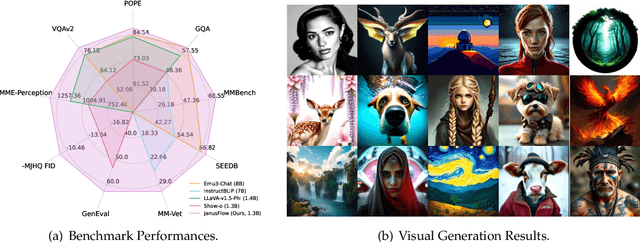
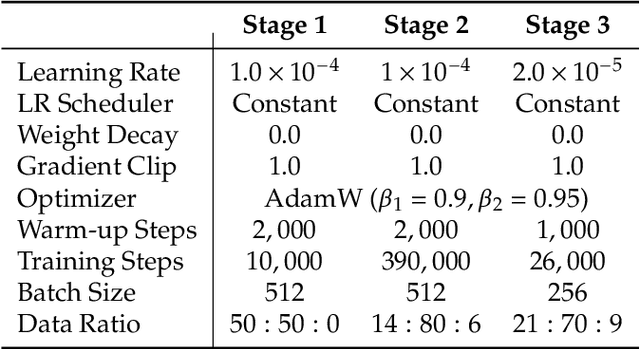

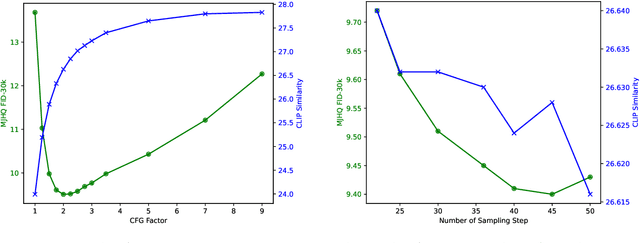
Abstract:We present JanusFlow, a powerful framework that unifies image understanding and generation in a single model. JanusFlow introduces a minimalist architecture that integrates autoregressive language models with rectified flow, a state-of-the-art method in generative modeling. Our key finding demonstrates that rectified flow can be straightforwardly trained within the large language model framework, eliminating the need for complex architectural modifications. To further improve the performance of our unified model, we adopt two key strategies: (i) decoupling the understanding and generation encoders, and (ii) aligning their representations during unified training. Extensive experiments show that JanusFlow achieves comparable or superior performance to specialized models in their respective domains, while significantly outperforming existing unified approaches across standard benchmarks. This work represents a step toward more efficient and versatile vision-language models.
Idempotent Unsupervised Representation Learning for Skeleton-Based Action Recognition
Oct 27, 2024Abstract:Generative models, as a powerful technique for generation, also gradually become a critical tool for recognition tasks. However, in skeleton-based action recognition, the features obtained from existing pre-trained generative methods contain redundant information unrelated to recognition, which contradicts the nature of the skeleton's spatially sparse and temporally consistent properties, leading to undesirable performance. To address this challenge, we make efforts to bridge the gap in theory and methodology and propose a novel skeleton-based idempotent generative model (IGM) for unsupervised representation learning. More specifically, we first theoretically demonstrate the equivalence between generative models and maximum entropy coding, which demonstrates a potential route that makes the features of generative models more compact by introducing contrastive learning. To this end, we introduce the idempotency constraint to form a stronger consistency regularization in the feature space, to push the features only to maintain the critical information of motion semantics for the recognition task. Our extensive experiments on benchmark datasets, NTU RGB+D and PKUMMD, demonstrate the effectiveness of our proposed method. On the NTU 60 xsub dataset, we observe a performance improvement from 84.6$\%$ to 86.2$\%$. Furthermore, in zero-shot adaptation scenarios, our model demonstrates significant efficacy by achieving promising results in cases that were previously unrecognizable. Our project is available at \url{https://github.com/LanglandsLin/IGM}.
MacDiff: Unified Skeleton Modeling with Masked Conditional Diffusion
Sep 16, 2024
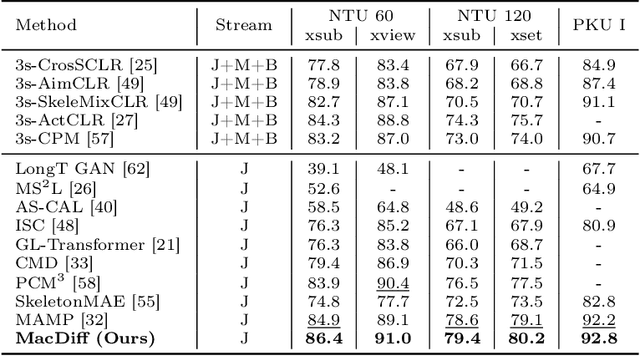

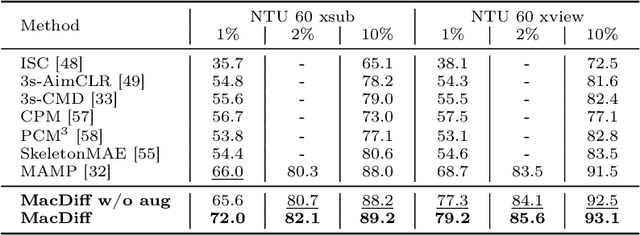
Abstract:Self-supervised learning has proved effective for skeleton-based human action understanding. However, previous works either rely on contrastive learning that suffers false negative problems or are based on reconstruction that learns too much unessential low-level clues, leading to limited representations for downstream tasks. Recently, great advances have been made in generative learning, which is naturally a challenging yet meaningful pretext task to model the general underlying data distributions. However, the representation learning capacity of generative models is under-explored, especially for the skeletons with spacial sparsity and temporal redundancy. To this end, we propose Masked Conditional Diffusion (MacDiff) as a unified framework for human skeleton modeling. For the first time, we leverage diffusion models as effective skeleton representation learners. Specifically, we train a diffusion decoder conditioned on the representations extracted by a semantic encoder. Random masking is applied to encoder inputs to introduce a information bottleneck and remove redundancy of skeletons. Furthermore, we theoretically demonstrate that our generative objective involves the contrastive learning objective which aligns the masked and noisy views. Meanwhile, it also enforces the representation to complement for the noisy view, leading to better generalization performance. MacDiff achieves state-of-the-art performance on representation learning benchmarks while maintaining the competence for generative tasks. Moreover, we leverage the diffusion model for data augmentation, significantly enhancing the fine-tuning performance in scenarios with scarce labeled data. Our project is available at https://lehongwu.github.io/ECCV24MacDiff/.
FBSDiff: Plug-and-Play Frequency Band Substitution of Diffusion Features for Highly Controllable Text-Driven Image Translation
Aug 06, 2024



Abstract:Large-scale text-to-image diffusion models have been a revolutionary milestone in the evolution of generative AI and multimodal technology, allowing wonderful image generation with natural-language text prompt. However, the issue of lacking controllability of such models restricts their practical applicability for real-life content creation. Thus, attention has been focused on leveraging a reference image to control text-to-image synthesis, which is also regarded as manipulating (or editing) a reference image as per a text prompt, namely, text-driven image-to-image translation. This paper contributes a novel, concise, and efficient approach that adapts pre-trained large-scale text-to-image (T2I) diffusion model to the image-to-image (I2I) paradigm in a plug-and-play manner, realizing high-quality and versatile text-driven I2I translation without any model training, model fine-tuning, or online optimization process. To guide T2I generation with a reference image, we propose to decompose diverse guiding factors with different frequency bands of diffusion features in the DCT spectral space, and accordingly devise a novel frequency band substitution layer which realizes dynamic control of the reference image to the T2I generation result in a plug-and-play manner. We demonstrate that our method allows flexible control over both guiding factor and guiding intensity of the reference image simply by tuning the type and bandwidth of the substituted frequency band, respectively. Extensive qualitative and quantitative experiments verify superiority of our approach over related methods in I2I translation visual quality, versatility, and controllability. The code is publicly available at: https://github.com/XiangGao1102/FBSDiff.
Intelligent Artistic Typography: A Comprehensive Review of Artistic Text Design and Generation
Jul 20, 2024Abstract:Artistic text generation aims to amplify the aesthetic qualities of text while maintaining readability. It can make the text more attractive and better convey its expression, thus enjoying a wide range of application scenarios such as social media display, consumer electronics, fashion, and graphic design. Artistic text generation includes artistic text stylization and semantic typography. Artistic text stylization concentrates on the text effect overlaid upon the text, such as shadows, outlines, colors, glows, and textures. By comparison, semantic typography focuses on the deformation of the characters to strengthen their visual representation by mimicking the semantic understanding within the text. This overview paper provides an introduction to both artistic text stylization and semantic typography, including the taxonomy, the key ideas of representative methods, and the applications in static and dynamic artistic text generation. Furthermore, the dataset and evaluation metrics are introduced, and the future directions of artistic text generation are discussed. A comprehensive list of artistic text generation models studied in this review is available at https://github.com/williamyang1991/Awesome-Artistic-Typography/.
Shap-Mix: Shapley Value Guided Mixing for Long-Tailed Skeleton Based Action Recognition
Jul 17, 2024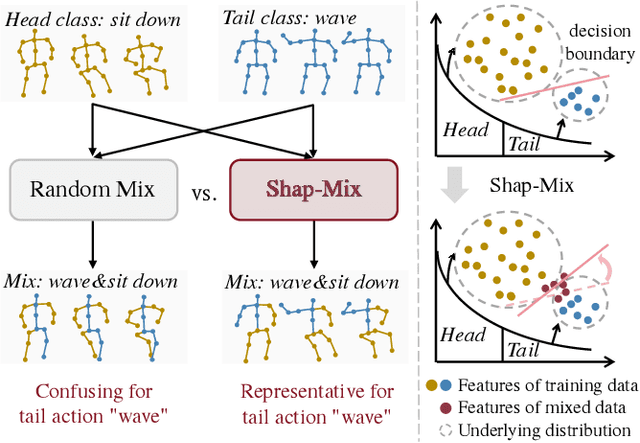
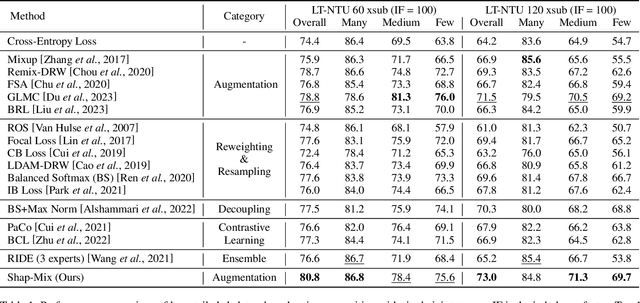
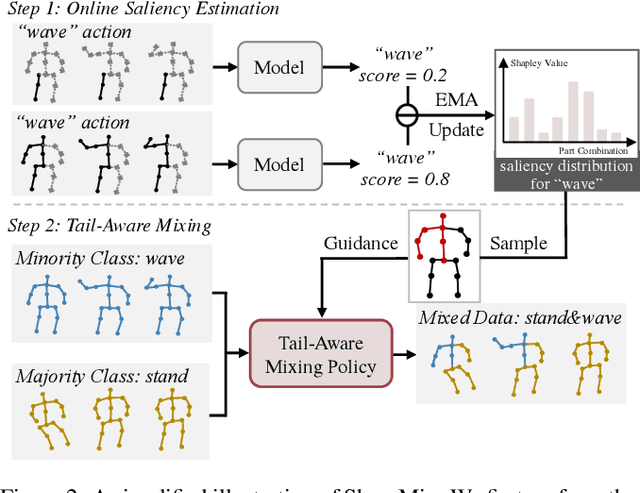

Abstract:In real-world scenarios, human actions often fall into a long-tailed distribution. It makes the existing skeleton-based action recognition works, which are mostly designed based on balanced datasets, suffer from a sharp performance degradation. Recently, many efforts have been madeto image/video long-tailed learning. However, directly applying them to skeleton data can be sub-optimal due to the lack of consideration of the crucial spatial-temporal motion patterns, especially for some modality-specific methodologies such as data augmentation. To this end, considering the crucial role of the body parts in the spatially concentrated human actions, we attend to the mixing augmentations and propose a novel method, Shap-Mix, which improves long-tailed learning by mining representative motion patterns for tail categories. Specifically, we first develop an effective spatial-temporal mixing strategy for the skeleton to boost representation quality. Then, the employed saliency guidance method is presented, consisting of the saliency estimation based on Shapley value and a tail-aware mixing policy. It preserves the salient motion parts of minority classes in mixed data, explicitly establishing the relationships between crucial body structure cues and high-level semantics. Extensive experiments on three large-scale skeleton datasets show our remarkable performance improvement under both long-tailed and balanced settings. Our project is publicly available at: https://jhang2020.github.io/Projects/Shap-Mix/Shap-Mix.html.
Frequency-Controlled Diffusion Model for Versatile Text-Guided Image-to-Image Translation
Jul 03, 2024



Abstract:Recently, large-scale text-to-image (T2I) diffusion models have emerged as a powerful tool for image-to-image translation (I2I), allowing open-domain image translation via user-provided text prompts. This paper proposes frequency-controlled diffusion model (FCDiffusion), an end-to-end diffusion-based framework that contributes a novel solution to text-guided I2I from a frequency-domain perspective. At the heart of our framework is a feature-space frequency-domain filtering module based on Discrete Cosine Transform, which filters the latent features of the source image in the DCT domain, yielding filtered image features bearing different DCT spectral bands as different control signals to the pre-trained Latent Diffusion Model. We reveal that control signals of different DCT spectral bands bridge the source image and the T2I generated image in different correlations (e.g., style, structure, layout, contour, etc.), and thus enable versatile I2I applications emphasizing different I2I correlations, including style-guided content creation, image semantic manipulation, image scene translation, and image style translation. Different from related approaches, FCDiffusion establishes a unified text-guided I2I framework suitable for diverse image translation tasks simply by switching among different frequency control branches at inference time. The effectiveness and superiority of our method for text-guided I2I are demonstrated with extensive experiments both qualitatively and quantitatively. The code is publicly available at: https://github.com/XiangGao1102/FCDiffusion.
* Proceedings of the 38th AAAI Conference on Artificial Intelligence (AAAI 2024)
Coding for Intelligence from the Perspective of Category
Jul 02, 2024



Abstract:Coding, which targets compressing and reconstructing data, and intelligence, often regarded at an abstract computational level as being centered around model learning and prediction, interweave recently to give birth to a series of significant progress. The recent trends demonstrate the potential homogeneity of these two fields, especially when deep-learning models aid these two categories for better probability modeling. For better understanding and describing from a unified perspective, inspired by the basic generally recognized principles in cognitive psychology, we formulate a novel problem of Coding for Intelligence from the category theory view. Based on the three axioms: existence of ideal coding, existence of practical coding, and compactness promoting generalization, we derive a general framework to understand existing methodologies, namely that, coding captures the intrinsic relationships of objects as much as possible, while ignoring information irrelevant to downstream tasks. This framework helps identify the challenges and essential elements in solving the specific derived Minimal Description Length (MDL) optimization problem from a broader range, providing opportunities to build a more intelligent system for handling multiple tasks/applications with coding ideas/tools. Centering on those elements, we systematically review recent processes of towards optimizing the MDL problem in more comprehensive ways from data, model, and task perspectives, and reveal their impacts on the potential CfI technical routes. After that, we also present new technique paths to fulfill CfI and provide potential solutions with preliminary experimental evidence. Last, further directions and remaining issues are discussed as well. The discussion shows our theory can reveal many phenomena and insights about large foundation models, which mutually corroborate with recent practices in feature learning.
 Add to Chrome
Add to Chrome Add to Firefox
Add to Firefox Add to Edge
Add to Edge